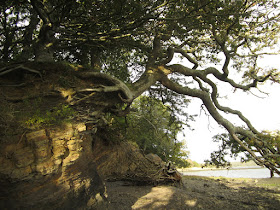It appears that certain people are very sceptical about the manner in which biomechanical processes operate in woodland ecosystems. Strange, since we see them operating almost every day. At the top of the bank in our garden we have a large ash tree embedded in a stone wall. Every now and then the stone wall collapses and has to be rebuilt, because of two observable processes: the gradual and inexorable process of root expansion, and the rocking of the tree in high winds. Both processes push out very heavy stones, some of them far too heavy to lift.
This is one of my photos from Rhosyfelin, showing a large block of rhyolite that has already been separated from the rock face because of root expansion and the rocking of shrubs -- in this case gorse and heather.
Message: don't stand under the Rhosyfelin rock face when there is a strong gale blowing and when there has been heavy rain (water acts as a lubricant, reducing friction and enhancing the likelihood that the block will slide and fall over).
For even more spectacular examples of the work that trees can do, just visit Picton Ferry at the junction between the Eastern and Western Cleddau rivers. Here are some of my photos:
Some of these trees are well over 100 years old, and as the coastline retreats because of wave sapping (not very powerful here, but over a long period of time things happen) the trees that were standing vertically in the wood get undermined and fall over. They try to compensate by putting up vertical branches, but they become increasingly top-heavy and unstable. There is a certain amount of mechanical destruction of the rock cliff because of the sheer weight of some of these trees (the rocks here are not very coherent -- soft sandstones, shales and gritstones of the Coal Measures), but more important still are root expansion and tree rocking in high winds.
As long as there is a process capable of removing dislodged debris, such as wave sapping on a coastline, or water flow for river-bank situations, these biomechanical processes are capable of achieving a great deal of work in the destruction of rock faces.
Here's a fun photo. It's from a pine forest in Poland, where a cluster of young saplings was flattened and bent over by a heavy snowfall, which must have created a snow-bank which remained in position for several months -- enough to prevent the saplings from bouncing up again when the snow melted. However, the damage was not sufficient to kill the trees, and they kept growing in the following seasons, malformed as a result of their traumatic experience.






Many moons ago we were at Trefgarne quarry, it was in the summer a dry day but there was a strong wind blowing. While there we saw a tree that was growing out of the rock face rocking back and forth. Next thing there was a splitting noise and a sizeable chunk of the rock face was tumbling over and over and ended up crashing into the flooded quarry causing quite a wave . The roots of the tree were exposed and over the next half hour it toppled over and that was the end of this tree as well.....
ReplyDeleteScary! I was camped up at Lion Rock once, also many moons ago, during a deluge, and during the night I was woken up several times by stones crashing down rather noisily. Luckily, I was far enough away from the rock face to have been in no danger -- but it taught me that geomorphological processes are alive and well.....
ReplyDelete